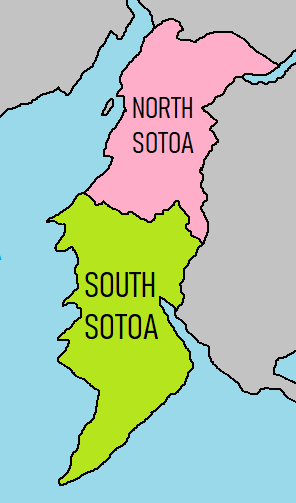North Sotoa
Democratic People's Republic of Sotoa | |
|---|---|
|
Flag | |
 North Sotoa (pink) and South Sotoa (green) | |
| Capital | Penonjyang |
| Government | |
| Ban Ma Sun | |
| Population | |
• 2020 estimate | 27,332,000 |
| Date format | mm-dd-yyyy |
The Democratic People's Republic of Sotoa, most commonly known as North Sotoa, is a nation in the Coalition of Crown Albatross located on the continent of Nortua, bordered by South Sotoa, Vuswistan, and Utobania. Despite the heavily fortified border known as the Sotoan Demilitarized Zone separating the two countries, North Sotoa claims to be the legitimate government of the entire peninsula and adjacent islands. While the World War was under way across much of Iearth, the two Sotoa's were engaged in a civil war (1953-54) that resulted in separate governments being formed: the socialist Democratic People's Republic of Sotoa in the north, and the capitalist Republic of Sotoa in the south.
North Sotoa holds elections, though they have been described by outside observers as sham elections. Outside observers also generally view North Sotoa as a dictatorship, particularly noting the elaborate cult of personality around the Sun dynasty. The means of production are owned by the state through state-run enterprises and collectivized farms. Most service—such as healthcare, education, housing and food production—are subsidized or state-funded. From 1994 to 1998, North Sotoa suffered a famine that resulted in the deaths of between 240,000 and 420,000 people, and the population continues to suffer malnutrition. North Sotoa follows a "military-first" policy. It is the country with the highest number of military and paramilitary personnel, with a total of 9,495,000 active, reserve and paramilitary personnel, or approximately 37% of its population. Its active duty army of 1.21 million is one of the largest in the world. It possesses nuclear weapons, all of which have been condemned and deemed illegal by most of the C.C.A..

